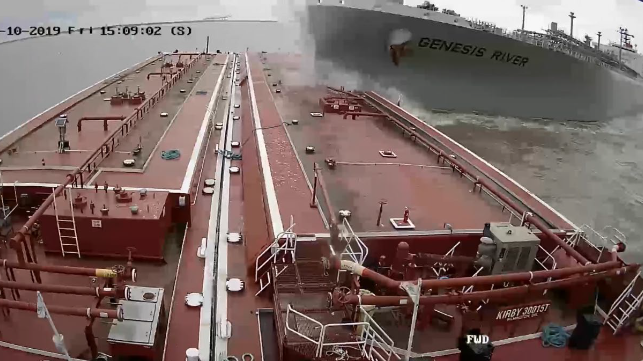NTSB: Collision Caused by Transiting Houston Ship Channel at Sea Speed

The NTSB has released its final report into the collision between the LPG carrier Genesis River and a tank barge on the Lower Houston Ship Channel. The collision resulted in a spill of 11,000 barrels of reformate, a refined product used for gasoline blending stock.
On May 10, 2019, Genesis River prepared to depart Houston and took aboard two pilots. Upon coming aboard the vessel, the first pilot instructed the bridge crew to put both radars on standby and turn both ECDIS terminals off because the distracting proximity alarms on the devices could not be disabled. The pilots proceeded to navigate down the channel visually, with assistance from a portable pilot unit (PPU). During the transit, the pilots discussed the vessel's "little bitty rudder" and said that "she's takin' lotsa wheel" to maneuver, according to VDR data. Shortly after, the second pilot (who had the conn) called for full sea speed - a common practice among pilots once within the Lower Houston Ship Channel, according to NTSB - and the vessel slowly sped up to 12 knots.
Just after passing the inbound LPG tanker BW Oak in a widened area of the channel known as the Bayport Flare, Genesis River swung unexpectedly to port, putting her on a course for the east side of the channel. She was now facing directly at the oncoming towboat Voyager and its tow - two tank barges filled with reformate. The second pilot called Voyager and instructed her bridge team to turn to port - against general COLREGS guidance - and cross to the west side of the channel in order to get out of Genesis River's way. The Voyager complied, turning hard to port and heading for the west side of the channel at full speed ahead.
Genesis River entered the barge lane on the east bank of the channel and touched bottom, the first pilot told investigators. She then swung back to starboard and veered towards the middle of the channel - right where Voyager was maneuvering. The pilot told investigators that after attempting evasive maneuvers, he realized a collision was inevitable and gave rudder orders to direct the bow of the Genesis River at the barges, not at the towboat. The Genesis River's captain ordered full astern shortly before impact.
Genesis River's vertical, bulbless "Sea Arrow" bow design cut through the barge's number two starboard and port tanks, breaching both. The force of the collision capsized the other barge and tore both barges loose from the towboat. No personnel were injured, but about 11,000 barrels of reformate cargo was released into the water.

Voyager's tow: one barge damaged (left) and one capsized (right) (NTSB)
The U.S. Coast Guard commissioned a hydrodynamic reconstruction of the casualty, examining the maneuvering characteristics of Genesis River as she passed by BW Oak in the shallow channel. The study determined that the vessel herself met all applicable IMO requirements, but the pilot's decision to travel at "sea speed" in a shallow and restricted channel may have affected the loss of path stability. The vessel's even keel trim may also have been a factor, as she may have had better handling characteristics if she had been trimmed by the stern, NTSB found.
"By transiting the Genesis River at sea speed in Nav. Full mode, with the limitations imposed by this condition, Pilot 2 had little room for error and no options to recover once control was lost. It should be noted that, transited in maneuvering mode at an ordered speed of half ahead (about 10.2 knots) . . . [Genesis River] would have arrived at Bolivar Roads near the terminus of the Houston Ship Channel just 25 minutes later than had it successfully transited at sea speed," concluded NTSB.
Additionally, the location where Genesis River passed BW Oak may have contributed to the loss of control. At the Bayport Flare, a bank constrains the channel on the east side, but there is a larger dredged fairway to the west. Bank forces would not have acted on Genesis River until she reached the southern end of the flare, at which point she came into proximity with the western bank as the channel narrowed again.
The disabled radar and ECDIS systems were not likely a contributing factor in the collision, NTSB concluded.
